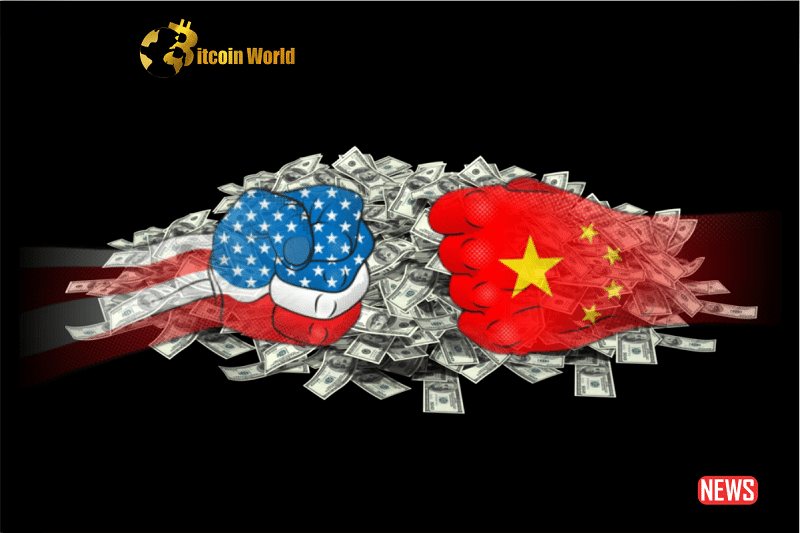The global financial landscape is undergoing a fascinating transformation, and at the heart of it lies the evolving relationship between the world’s two biggest economic powerhouses: the United States and China. Whispers of de-dollarization, the process of countries reducing their reliance on the US dollar, are growing louder. But is this a genuine threat, or just speculative chatter? Let’s dive into what’s fueling this discussion and what it could mean for the future.
Why is Everyone Talking About De-Dollarization Now?
Analysts at JPMorgan have flagged a crucial factor: the escalating geopolitical tensions between the US and China. Think of it like this: when two giants are locked in a power struggle, the ripples are felt far and wide. These tensions aren’t just about trade; they’re about influence, technology, and the future global order. JPMorgan suggests that if these tensions continue to intensify, the push for de-dollarization could gain significant momentum. Imagine a scenario where countries, wary of being caught in the crossfire, start seeking alternatives to the dollar for trade and reserves.
Could a New Cold War Trigger De-Dollarization?
The comparison to a new Cold War isn’t far-fetched. Increased competition between the US and China could lead to a fragmented global economy, a move away from the interconnectedness we’ve seen in recent decades. This deglobalization in trade and finance could naturally lead nations to explore alternative currencies and payment systems, diminishing the dollar’s central role. Think of it as diversifying your portfolio – countries might want to spread their risk rather than relying solely on one currency.
What Role Do Internal US Politics Play?
It’s not just about external pressures. Internal political dynamics within the US can also impact the dollar’s standing. Remember the recent debt ceiling debate? The near brush with a potential US default sent shivers down the spines of global markets. When the world’s leading economy faces such uncertainties, it naturally raises questions about the long-term stability of its currency. Meanwhile, China has been actively pursuing market-friendly reforms, signaling its ambition on the global economic stage. This contrast can make other nations consider China as a potentially more reliable partner.
China’s Ascendancy: A Direct Challenge to the Dollar?
China’s growing economic clout and its proactive reforms are undeniable factors in the de-dollarization conversation. The potential easing of capital controls in China could make the yuan a more attractive option for international trade and investment, particularly for countries that don’t align economically with the US. This could lead to what analysts call a “partial de-dollarisation process,” where the dollar’s dominance isn’t completely overturned, but its share of the pie shrinks as the yuan gains ground.
Will the Dollar Lose Its Crown?
Despite all these factors, JPMorgan analysts believe a complete dethroning of the US dollar as the world’s reserve currency in the next decade is highly improbable. Why? Because the dollar’s status is deeply entrenched. It’s been the bedrock of the global financial system for decades, offering stability and trust that’s hard to replicate overnight. Think of the infrastructure built around the dollar – from payment systems to established trade routes. Shifting away from that is a monumental task.
The Dollar’s Strengths and Challenges: A Quick Look
Let’s break down the key factors influencing the dollar’s position:
- Strengths of the US Dollar:
- Deep and liquid financial markets
- Strong legal and institutional framework
- Widespread acceptance and usage in global trade
- Historical precedent and established trust
- Challenges to the US Dollar:
- Geopolitical tensions with China and other nations
- Internal US political instability and debt concerns
- Rise of alternative currencies and payment systems
- Potential for increased use of local currencies in trade
What Does This Mean for the Future?
While a sudden collapse of the dollar’s dominance is unlikely, the trends suggest a gradual shift. We might see a world where the dollar remains a major player, but other currencies, particularly the yuan, gain increasing prominence. This could lead to a more multi-polar financial system, which could have both benefits and challenges.
Key Takeaways: What to Watch For
- Geopolitical Developments: Keep a close eye on the relationship between the US and China. Any further escalation could accelerate de-dollarization efforts.
- China’s Economic Reforms: Monitor the progress of China’s market-opening measures and the internationalization of the yuan.
- US Fiscal Policy: Pay attention to US government debt levels and political stability.
- Emerging Market Trends: Observe how other countries are diversifying their reserves and trade settlements.
Conclusion: Navigating the Shifting Tides
The potential for de-dollarization, fueled by US-China tensions and internal US dynamics, is a complex and evolving story. While the dollar’s reign isn’t ending anytime soon, the rise of alternative currencies and the desire for diversification are undeniable trends. Market participants and policymakers alike will need to closely monitor these developments to understand the reshaping global financial landscape. The future likely holds a more nuanced picture, where the dollar coexists with other significant currencies, reflecting a world of shifting economic power and evolving geopolitical realities.
Disclaimer: The information provided is not trading advice, Bitcoinworld.co.in holds no liability for any investments made based on the information provided on this page. We strongly recommend independent research and/or consultation with a qualified professional before making any investment decisions.


